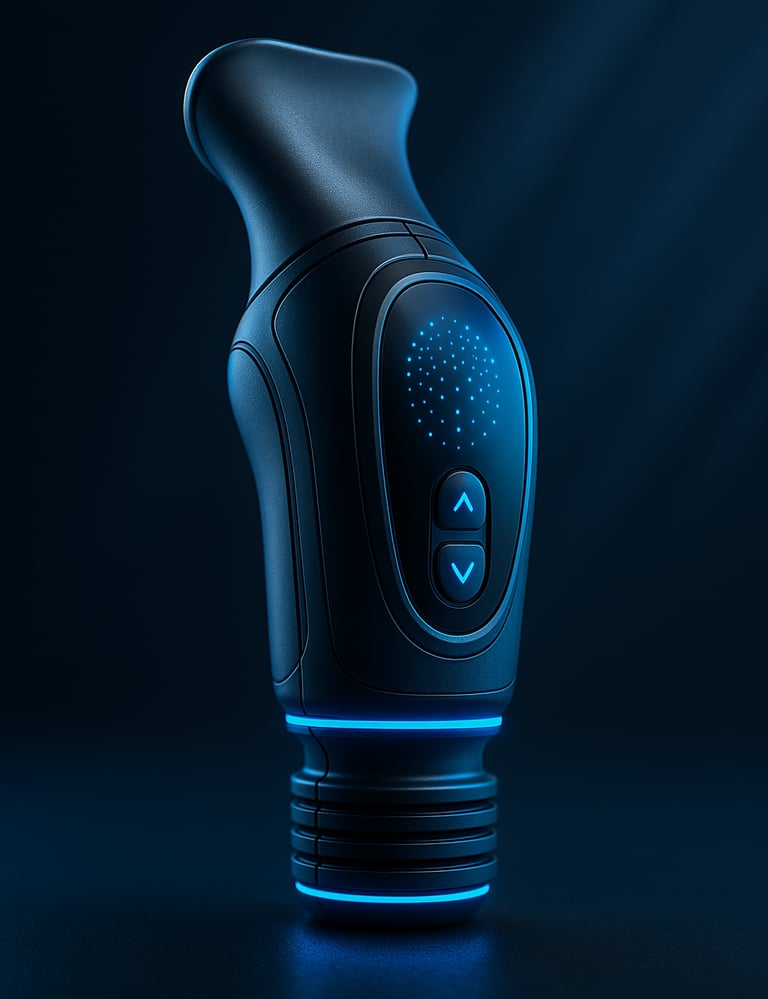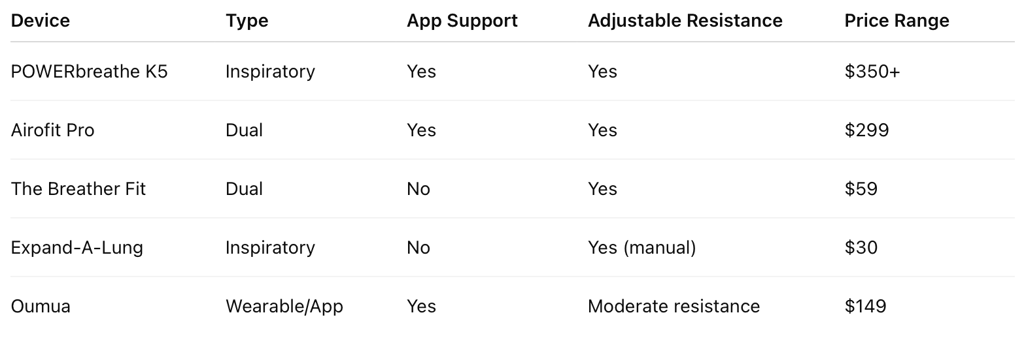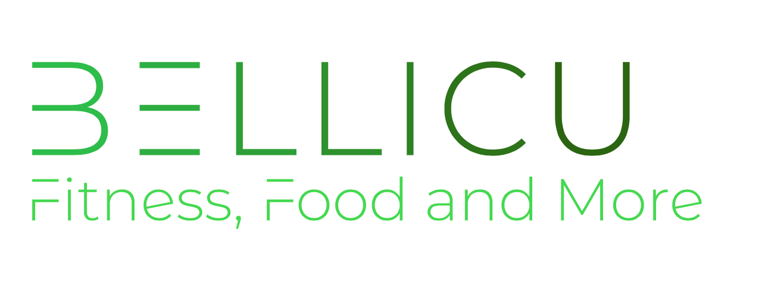

Breath Training Devices
Can You Hack Cardio Endurance Through Breathing?
Why Breathing Matters More Than You Think
Breathing is the most fundamental movement of your life — yet most of us rarely think about it. During cardio-heavy efforts like running, cycling, or HIIT, your ability to deliver oxygen efficiently determines how hard and how long you can go. That’s where the concept of respiratory muscle training (RMT) comes in.
The diaphragm and intercostal muscles — the ones responsible for inhalation and exhalation — are trainable, just like your biceps or glutes. When these muscles fatigue, your brain prioritizes breathing over limb movement, causing you to slow down or stop. That’s a protective mechanism… but it’s also a performance limiter.
Breath training aims to delay this fatigue, boost oxygen uptake, and improve endurance — not just through cardiovascular adaptations, but by enhancing the mechanical efficiency of how you breathe.
What Are Breath Training Devices?
Breath training devices are compact tools — often handheld or wearable — that aim to strengthen your respiratory muscles by adding resistance to the act of breathing. Just as lifting weights challenges your muscles to grow stronger, these devices create a form of “lung resistance training” that forces your diaphragm and intercostal muscles to work harder.
Most breath training devices operate on a simple principle: restrict airflow in a controlled way so your body adapts by making breathing more efficient and powerful over time. Depending on the design, they can target inhalation, exhalation, or both.
Types of Breath Training Devices
1. Inspiratory Muscle Trainers (IMT)
These focus specifically on restricting air during inhalation. By making it harder to breathe in, they train the diaphragm and accessory breathing muscles to pull air in more forcefully and efficiently.
Example devices:
POWERbreathe K-Series (digital feedback + adjustable resistance)
Expand-A-Lung (simple mechanical valve)
Best for: Athletes looking to increase inspiratory strength, people with shortness of breath during exercise, and anyone aiming to improve VO₂ max.
2. Expiratory Muscle Trainers (EMT)
Less common but equally important, EMTs add resistance during exhalation. These are useful for strengthening muscles that control breath release, which can aid in better breath control and reduce air trapping in the lungs — especially beneficial for people with respiratory conditions.
Example devices:
EMST150 (often used in speech therapy and medical rehab)
Breather Voice (marketed to vocal professionals)
Best for: Vocalists, wind instrument musicians, individuals in respiratory therapy, and some athletes.
3. Dual-Phase Trainers
These devices train both inspiration and expiration, providing a balanced workout for your entire breathing cycle. Resistance can usually be adjusted separately for inhale and exhale, allowing for personalized training plans.
Example devices:
The Breather Fit
Airofit Pro (includes Bluetooth app for guided training)
Best for: General respiratory muscle improvement, sports performance, breath-hold training, and recovery from illness or deconditioning.
4. Smart Wearable Breath Monitors
These are non-resistance devices designed to track and analyze your breathing patterns rather than physically train your lungs. Using sensors and apps, they offer biofeedback to help you become more aware of how you breathe during rest, exercise, or stress.
Example devices:
Spire Health Tag (tracks respiratory rate and stress patterns)
Oumua Trainer (guides breath control via haptics and app feedback)
Best for: People looking to improve mindfulness, reduce stress through better breathing habits, or incorporate breathwork into daily life without physical resistance.
Key Features to Look For
Most quality breath training devices include:
Adjustable resistance levels – allowing progressive overload as you get stronger
Ergonomic mouthpieces or nose clips – for a comfortable and secure fit
Portability – small and travel-friendly
App connectivity – in advanced models, for data tracking and guided workouts
Sanitary design – easy to clean and maintain
Digital models like Airofit Pro and POWERbreathe K5 even provide real-time feedback on inhalation pressure, lung capacity, and training load, making them suitable for athletes who want precision tracking and performance metrics.
How Do They Feel to Use?
Using a breath trainer may feel strange at first — imagine breathing through a narrow straw or a blocked snorkel. The goal is not to restrict oxygen dangerously, but to create just enough resistance to fatigue the breathing muscles. Over time, most users report easier breathing during workouts, reduced breathlessness, and improved endurance.
A common starting point is two sessions per day, with 30 slow, controlled breaths per session, gradually increasing resistance as your strength improves.
The Science Behind Breath Training
Let’s cut to the core: Do breath training devices actually work, or are they just fitness gimmicks?
The answer, backed by science, is that they do work — but results vary based on your starting point, training level, and how consistently you use them.
Clinical Findings: Evidence You Can Breathe Easy With
Multiple peer-reviewed studies and meta-analyses have explored the effectiveness of respiratory muscle training (RMT) — the broader term encompassing inspiratory and expiratory muscle training. Here’s what the research shows:
A 2019 meta-analysis in Sports Medicine examined 21 randomized trials involving athletes. The researchers found statistically significant improvements in VO₂ max (a key marker of aerobic fitness) and longer time to exhaustion during endurance tests in individuals using inspiratory muscle training (IMT).
Translation: Breath training helped people go farther and longer.A 2021 study in the Journal of Strength and Conditioning Research tested recreationally trained runners using a resistance-based breathing device daily. After just four weeks, runners showed a 3.1% improvement in their 5K performance. That’s a meaningful gain, especially for already-fit individuals.
Clinical populations also benefit. Patients with COPD, asthma, or heart failure have shown marked improvements in dyspnea scores (shortness of breath), functional walking tests (like the 6-minute walk test), and quality of life following breath training interventions.
Older adults using breath resistance devices demonstrated increased inspiratory muscle strength and reduced fatigue during daily activities. This suggests a preventive and rehabilitative role, not just a performance one.
How Does Breath Training Actually Work?
Breath training triggers specific physiological adaptations that improve your breathing efficiency, stamina, and overall oxygen delivery during exercise. Think of it as hypertrophy and neural efficiency — but for your respiratory system.
Key Adaptations Include:
Increased Inspiratory Muscle Strength
Stronger diaphragm and accessory breathing muscles reduce the relative effort of each breath, allowing you to maintain pace longer before hitting a “respiratory wall.”Improved Tidal Volume
You can pull in more air per breath, meaning better oxygen availability with fewer, deeper breaths. This is critical in endurance sports where shallow over-breathing limits performance.Reduced Dyspnea (Breathlessness)
As your breathing muscles fatigue more slowly, you experience less shortness of breath during intense exertion.Lower Perceived Exertion at a Given Intensity
Some studies suggest breath training may blunt sympathetic nervous system activation, reducing how “hard” a workout feels — a major psychological benefit.Improved Ventilatory Efficiency
You use less oxygen to do the same work. Over time, this can translate into improved performance even in well-trained athletes.
Not All Gains Are Equal
While the research is promising, the magnitude of benefit depends on your baseline:
Untrained or moderately trained individuals often see the most dramatic gains. These populations typically have underdeveloped respiratory musculature and inefficient breathing patterns that can be improved quickly.
Elite endurance athletes, on the other hand, may see diminishing returns. Their respiratory systems are already highly trained through years of aerobic conditioning, making the potential for added performance improvement relatively small — though still measurable in elite competition.
Moreover, breath training should not be viewed as a magic bullet. It’s an adjunct to — not a replacement for — traditional endurance training.
How Long Until You See Results?
The adaptation timeline depends on the protocol and device used, but research suggests:
4 to 6 weeks of consistent use (typically 2 sessions/day, 30 breaths per session) is enough to trigger meaningful improvements.
Changes in VO₂ max, time to exhaustion, and RPE (rate of perceived exertion) are most noticeable in week 3–5.
Sustained improvements require ongoing use, much like strength or cardio training.
What the Experts Say
According to the American College of Sports Medicine (ACSM), respiratory muscle training is a validated method for improving exercise tolerance, especially in populations with respiratory or cardiovascular limitations.
The International Journal of Sports Physiology and Performance concludes that breath training “may provide marginal gains in high-level sport,” but can “significantly enhance perceived effort and breathing comfort during submaximal exercise.”
Limitations and Caveats
Breath training isn’t necessary for everyone. If your cardio fitness is already high and you're not struggling with breath control, you might not notice dramatic changes.
Placebo effect is possible in studies without proper blinding — especially in subjective metrics like RPE or dyspnea.
Technique matters: Incorrect use (rushing, breath holding, poor posture) can limit gains or cause dizziness.
Bottom Line: Backed by Science, Powered by Consistency
Breath training is not hype — it's a scientifically grounded tool that improves the efficiency and strength of your breathing. The physiological adaptations can enhance endurance, reduce fatigue, and optimize performance across a range of sports and populations.
But just like any fitness tool, it's only effective if used correctly, consistently, and in combination with a smart training program.
Breath Training vs. Traditional Cardio Improvements
You might wonder: Can breath training replace cardio training?
Short answer: No.
Breath training is a complement, not a substitute. Traditional endurance improvements come from:
Heart adaptations (increased stroke volume)
Muscle mitochondrial density
Improved lactate threshold
Blood plasma volume expansion
Breath training adds a unique layer, but only when used in conjunction with aerobic or anaerobic training. Think of it like core work for your lungs — helpful, but not a complete program.
Who Should Use Breath Training Devices?
Best-suited users include:
Endurance athletes (runners, cyclists, rowers)
CrossFit or HIIT participants who fatigue quickly
People recovering from respiratory illness
Older adults looking to maintain lung capacity
Singers and musicians who rely on breath control
Freedivers or surfers training for breath holds
However, individuals with severe asthma, uncontrolled hypertension, or cardiovascular limitations should consult a healthcare provider before starting breath resistance training.
Pros and Cons of Breath Training Devices
✅ Pros
Increases respiratory muscle strength
May enhance oxygen efficiency
Portable and easy to use
Scientifically supported for VO₂ max and endurance
Non-invasive and drug-free
❌ Cons
Gains may plateau in elite athletes
Some devices are expensive (~$150+)
Can cause dizziness if overused
Requires consistency over weeks for benefit
Limited effect without paired cardiovascular training
Popular Breath Training Devices Compared


Each of these devices varies in features and cost. App-supported models provide real-time coaching and progression tracking, ideal for data-driven athletes. Simpler tools like Expand-A-Lung offer budget-friendly access with no tech dependency.
Sample Breath Training Protocol for Endurance Athletes
If you’re curious to integrate breath training into your current routine, here’s a sample protocol for 4 weeks:
Week 1–2:
2x daily, 30 breaths/session
Light to moderate resistance
Seated position, post-workout
Week 3–4:
Increase resistance by one level
Add one session on active recovery days
Begin incorporating breath holds (2–3 per session)
Tips:
Inhale fully through the nose, exhale through the mouth
Maintain upright posture
Stop if lightheaded
Track perceived exertion and breath volume if your device allows
What About Nasal Breathing and Breath Holds?
Not all breath training involves devices. Some athletes use nasal breathing to force diaphragm engagement and limit overbreathing, especially during zone 2 cardio. Others practice breath-hold techniques (apnea training) for CO₂ tolerance and mental focus.
While these techniques are powerful, they typically do not strengthen the respiratory muscles the same way resistance devices do. However, combining them can create a comprehensive breathing optimization plan.
Final Verdict — Breath Training Isn’t Magic, But It Works
Breath training devices aren’t miracle tools — but they’re far from useless. When used consistently alongside a structured training plan, they can improve oxygen delivery, endurance, and even mental clarity under fatigue.
If you’re hitting a cardio plateau, recovering from illness, or just want to optimize every variable in your performance toolkit, breath training may be a smart addition.
When to Expect Results
Most studies suggest a 4–6 week adaptation period. Improvements are usually seen in:
Reduced breathlessness during effort
Faster recovery between intervals
Longer time to exhaustion
Track your progress via performance metrics (e.g., 5K time, FTP, HR recovery) — not just how “strong” your breathing feels.
Summary — Should You Try It?
If you're already training hard and eating right, improving your breathing may be the final frontier. Breath training is safe, evidence-based, and fits easily into even the busiest schedule.
Whether you choose a high-tech trainer or a budget model, remember: consistency beats complexity. The lungs may not be sexy — but they're essential.
✅ Try Breath Training
Looking to break through your endurance plateau? A few minutes of breath work each day might just change your entire performance game.
Reference List
Illi, S. K., Held, U., Frank, I., & Spengler, C. M. (2012). Effect of respiratory muscle training on exercise performance in healthy individuals: A systematic review and meta-analysis. Sports Medicine, 42(8), 707–724.
🔗 https://pubmed.ncbi.nlm.nih.gov/22804713/Archiza, B., Andaku, D. K., Caruso, F. C. R., Bonjorno, J. C., Oliveira, C. R., & Neder, J. A. (2018). Effects of inspiratory muscle training in professional women football players: A randomized sham-controlled trial. Journal of Sports Sciences, 36(7), 771–780.
🔗 https://pubmed.ncbi.nlm.nih.gov/28627223/McConnell, A. K., & Romer, L. M. (2004). Respiratory muscle training in healthy humans: Resolving the controversy. International Journal of Sports Medicine, 25(4), 284–293.
🔗 https://pubmed.ncbi.nlm.nih.gov/15160599/Karsten, M., Ribeiro, G. S., Esquivel, M. S., Matte, D. L., Rieder, M. M., & Stein, R. (2018). Effects of inspiratory muscle training on VO₂ max, inspiratory muscle strength, and muscle thickness in healthy subjects: A systematic review and meta-analysis. Clinical Rehabilitation, 32(12), 1572–1583.
🔗 https://pubmed.ncbi.nlm.nih.gov/30049291/HajGhanbari, B., Yamabayashi, C., Buna, T. R., Coelho, J. D., Freedman, K. D., Morton, T. A., et al. (2013). Effects of respiratory muscle training on performance in athletes: A systematic review with meta-analyses. Journal of Strength and Conditioning Research, 27(6), 1643–1663.
🔗 https://pubmed.ncbi.nlm.nih.gov/22836657/Illi, S. K., & Spengler, C. M. (2011). The influence of inspiratory muscle training on respiratory sensation, respiratory muscle work and exercise performance. Respiratory Physiology & Neurobiology, 179(1), 69–74.
🔗 https://pubmed.ncbi.nlm.nih.gov/21820377/Geddes, E. L., O’Brien, K., Reid, W. D., Brooks, D., & Crowe, J. (2008). Inspiratory muscle training in adults with chronic obstructive pulmonary disease: An update of a systematic review. Respiratory Medicine, 102(12), 1715–1729.
🔗 https://pubmed.ncbi.nlm.nih.gov/18789742/Bosnak-Guclu, M., Arikan, H., Savci, S., Inal-Ince, D., & Copur, B. (2011). Effects of inspiratory muscle training in patients with heart failure. Respiratory Medicine, 105(11), 1671–1681.
🔗 https://pubmed.ncbi.nlm.nih.gov/21872983/
